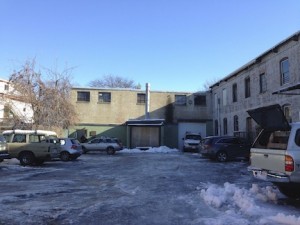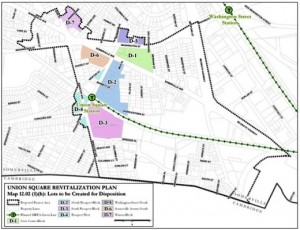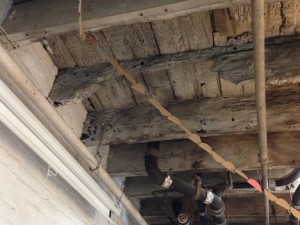A side or B side? Postindustrial artisans walking a fine line (Part II)
18 August 2014 – Cathy Stanton
Continued from Part 1.

“The B side” of the Fringe building was seen by one potential developer as part of what needs to be fixed in Union Square. Photo credit: Cathy Stanton
So how did the small-scale artisans at Fringe fit into the proposals put forward by the master developer candidates at the March meeting? The short answer is: ambiguously. They were clearly seen by the developers as both part of the hipness of the neighborhood and part of the set of problems–what in an earlier era of urban redevelopment was more bluntly termed “blight”–that the proposals aimed to overcome. This was made particularly clear by one presenter who showed slides of what he described as Union Square’s assets—a collage of logos from new-economy businesses, including Fringe’s—but then pointed to what he called “the B side,” ugly and problematic things that still needed to be fixed in the neighborhood. His slide for the B side included an image of Fringe’s entrance and loading-dock on the utilitarian back side of the IH Brown building, and he seemed unaware that the logo and the loading-dock belonged to the same enterprise. Lacking the high-tech polish of Artisan’s Asylum or GreenTown labs, Fringe is harder to pigeon-hole–and thus perhaps easier to overlook–in discussions about affordability and inclusivity within urban redevelopment.

Fringe’s building is just outside the revitalization zone but close to a new transit station and some of the parcels of land slated for redevelopment. Map credit: City of Somerville
The presenter who missed the connection between the A and B sides of Fringe did not make the final cut for the master developer role, and Mimi Graney remains a vocal champion of these more ambiguous businesses and the spaces they need if they are going to flourish. It may be that the well-established progressive elements of Somerville’s political culture will be stong enough to keep these questions on the table as the city’s revitalization plan moves closer to realization. But real estate prices, rents, and taxes are all rising rapidly in Union Square already, and studies of gentrification around the world suggest that when all is said and done, big money has a tendency to trump–or distort–civic values.
Other cities with strong progressive politics–most notably San Francisco–have seen a hollowing-out of civic discourse as knowledge- and tech-dominated economies and consumption-oriented planning really take hold. In a recent interview, San Franciscan writer Rebecca Solnit has lamented the way that “it feels like the place is being killed in some way,” pointing to how a lot of what made San Francisco interesting and edgy and politically generative for the environmental, gay rights, free thought, and other movements is being squeezed out by new Silicon Valley wealth. In a similar analysis from the New Yorker, Nathan Heller notes a glaring irony in the way that tech- and consumption-driven redevelopment is playing out in San Francisco: its supporters and opponents share similar values, at least on the surface. Yet in practice, the apparent liberalism of the workers, planners, and Chief Executive Officers of the new economy seems to translate into ever-wider socioeconomic gaps and impoverished political language for talking about those gaps.

The tough and unpolished industrial space of the building occupied by Fringe suits both the style and function of its collaborative companies. Photo credit: Cathy Stanton
Somewhere in between are small ventures like Fringe and the unassuming spaces that enable them to survive. Almost by definition, these spaces are old and formerly industrial–no one is erecting rough, utilitarian buildings in areas targeted for urban redevelopment. At a certain moment, the old and the new, the artisanal and the postindustrial, may be able to coexist. The “gritty” aspects of Union Square–its “B side”–have a certain cachet at present, and they are lucky to have articulate supporters who recognize their potential longer-term value in maintaining a diverse and inclusive urban environment. But maintaining that moment within a rising economy usually proves to be tricky. Public historians, preservationists, and others with an interest in protecting the physical fabric of older industrial neighborhoods should be alert to these existing uses and users as well and to the ambiguous positions they are attempting to sustain.
~ Cathy Stanton is a Senior Lecturer in Anthropology at Tufts University and Digital Media Editor for the National Council on Public History.




“big money has a tendency to trump–or distort–civic values” – yes indeed. And to destroy the real character of the places it “redevelops.” Already I am sick of faux-industrial hip eating places.